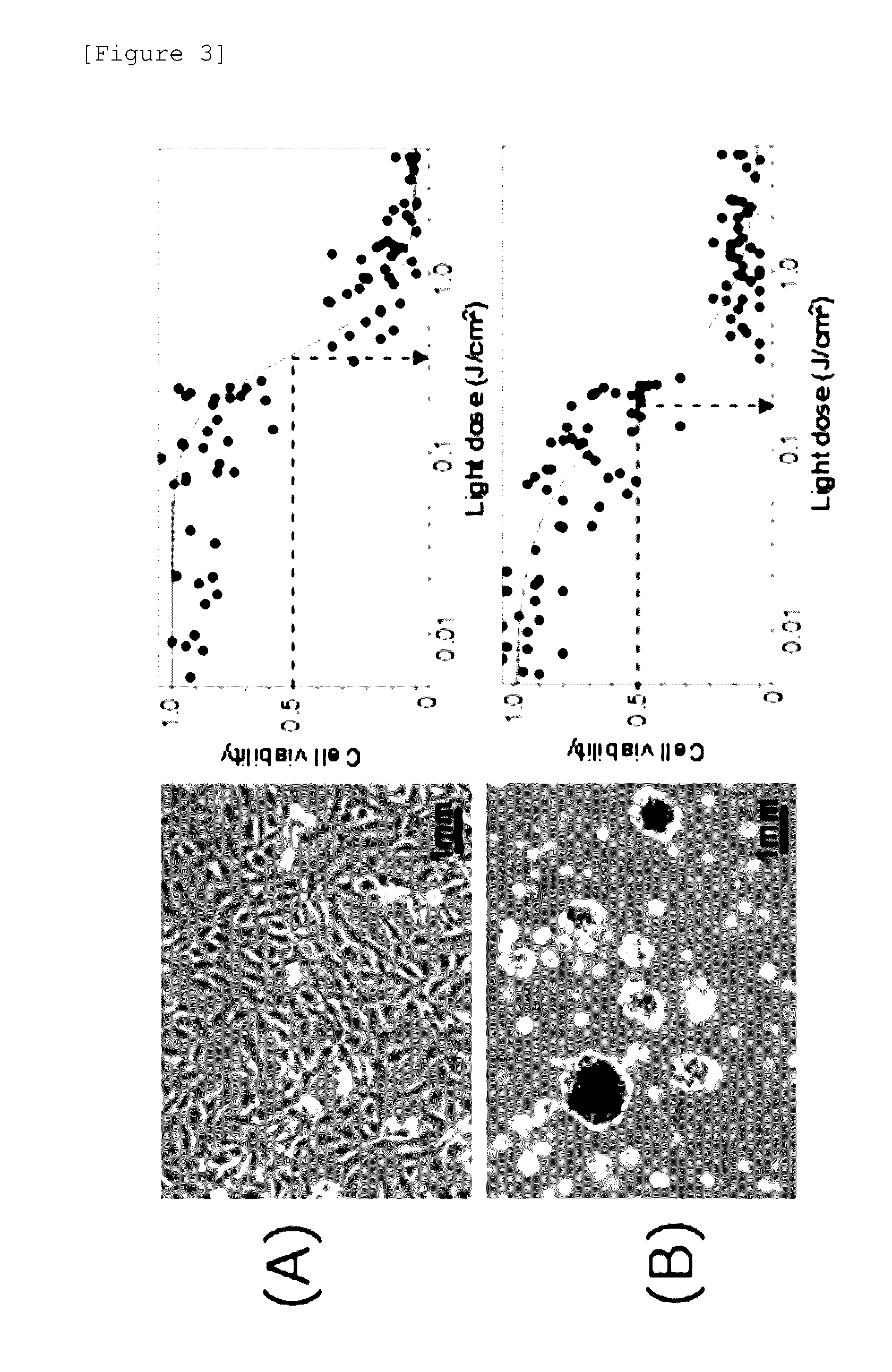Composition for prevention or treatment of treatment-resistant cancer
a technology for cancer and composition, applied in the direction of light therapy, drug compositions, therapy, etc., can solve the problems of low excretion speed, patient develops photosensitive dermatitis, and the pdt performed on malignant brain tumors, which involves the administration of ala, so as to reduce the risk of developing therapy-resistant cancer cells, improve the effect of ala-pdt, and improve the effect of treatment
- Summary
- Abstract
- Description
- Claims
- Application Information
AI Technical Summary
Benefits of technology
Problems solved by technology
Method used
Image
Examples
example 1
Culture of Cancer Stem Cells
Experimental Method
[0123]Studies regarding cancer stem cells have been conducted by applying a method of concentrating and separating normal tissue stem cells. Regarding leukemic stem cells, the studies have arrived at the stage of searching for therapeutic methods targeting cancer stem cells and / or the treatment using mouse models. On the other hand, regarding solid cancer, a method of separating and concentrating the relevant cancer cells has not yet been sufficiently established. In recent years, however, it has become possible to isolate brain tumor stem cells from a patient affected with malignant brain tumor, and to culture the cells. In the present experiment, stem cell lines, which had been isolated and established from a brain tumor patient based on these methods, have been used (Hemmati H D, Nakano I, Lazareff J A, Masterman-Smith M, Geschwind D H, Bronner-Fraser M, Kornblum H I. Cancerous stem cells can arise from pediatric brain tumors. Proc N...
example 2
Photosensitivity of Cancer Stem Cells to ALA-PDT
Experimental Method
[0126]Brain tumor stem cells (MD13, MD30, and 157NS cells), which had grown to a sphere type and a non-sphere type, were treated with trypsin, and thereafter, the resulting cells were each incubated at a density of 1.0×106 cells / ml, together with 0.3 mM ALA, for 4 hours. Thereafter, a 405-nm laser light was applied to the cells. After the cells had been cultured for 7 days, the cell viability was measured according to a viable cell count measurement method (WST-8 assay) using water soluble tetrazolium salts as a coloring reagent.
Results
[0127]FIG. 2 shows the plotting of the relationship between the intensity of the laser light and the cell viability. The sphere type cells (FIG. 2B) cultured in the D-MEM / F12 culture solution containing no FCS (containing L-glutamine, heparin, B27, EGF, and bFGF) had higher sensitivity to ALA-PDT, than the non-sphere type cells (FIG. 2A) cultured in the D-MEM / F12 culture solution conta...
example 3
Photosensitivity of Brain Tumor Cells to ALA-PDT
Experimental Method
[0128]The brain tumor cell line A172 (purchased from American Type Culture Collection) was cultured in a D-MEM / F12 culture solution containing no FCS (containing L-glutamine, heparin, B27, EGF, and bFGF). As a result, the cells formed a sphere similar to stem cells. On the other hand, when the cells were cultured in a D-MEM / F12 culture solution containing 10% FCS, the cells did not form such a sphere, and have grown to a plane shape. The cells, which had grown to a sphere type and a non-sphere type, were treated with trypsin. Subsequently, the cells were each incubated at a density of 1.0×106 cells / ml, together with 0.3 mM ALA, for 4 hours, and thereafter, a 405-nm laser light was applied to the cells. After the cells had been further cultured for 7 days, the cell viability was measured by a WST-8 assay in the same manner as that of Example 2.
[0129]Moreover, 500 cells were collected from A172 cells, on which ALA-PDT ...
PUM
| Property | Measurement | Unit |
|---|---|---|
| weight | aaaaa | aaaaa |
| weight | aaaaa | aaaaa |
| weight | aaaaa | aaaaa |
Abstract
Description
Claims
Application Information
 Login to View More
Login to View More - R&D
- Intellectual Property
- Life Sciences
- Materials
- Tech Scout
- Unparalleled Data Quality
- Higher Quality Content
- 60% Fewer Hallucinations
Browse by: Latest US Patents, China's latest patents, Technical Efficacy Thesaurus, Application Domain, Technology Topic, Popular Technical Reports.
© 2025 PatSnap. All rights reserved.Legal|Privacy policy|Modern Slavery Act Transparency Statement|Sitemap|About US| Contact US: help@patsnap.com



